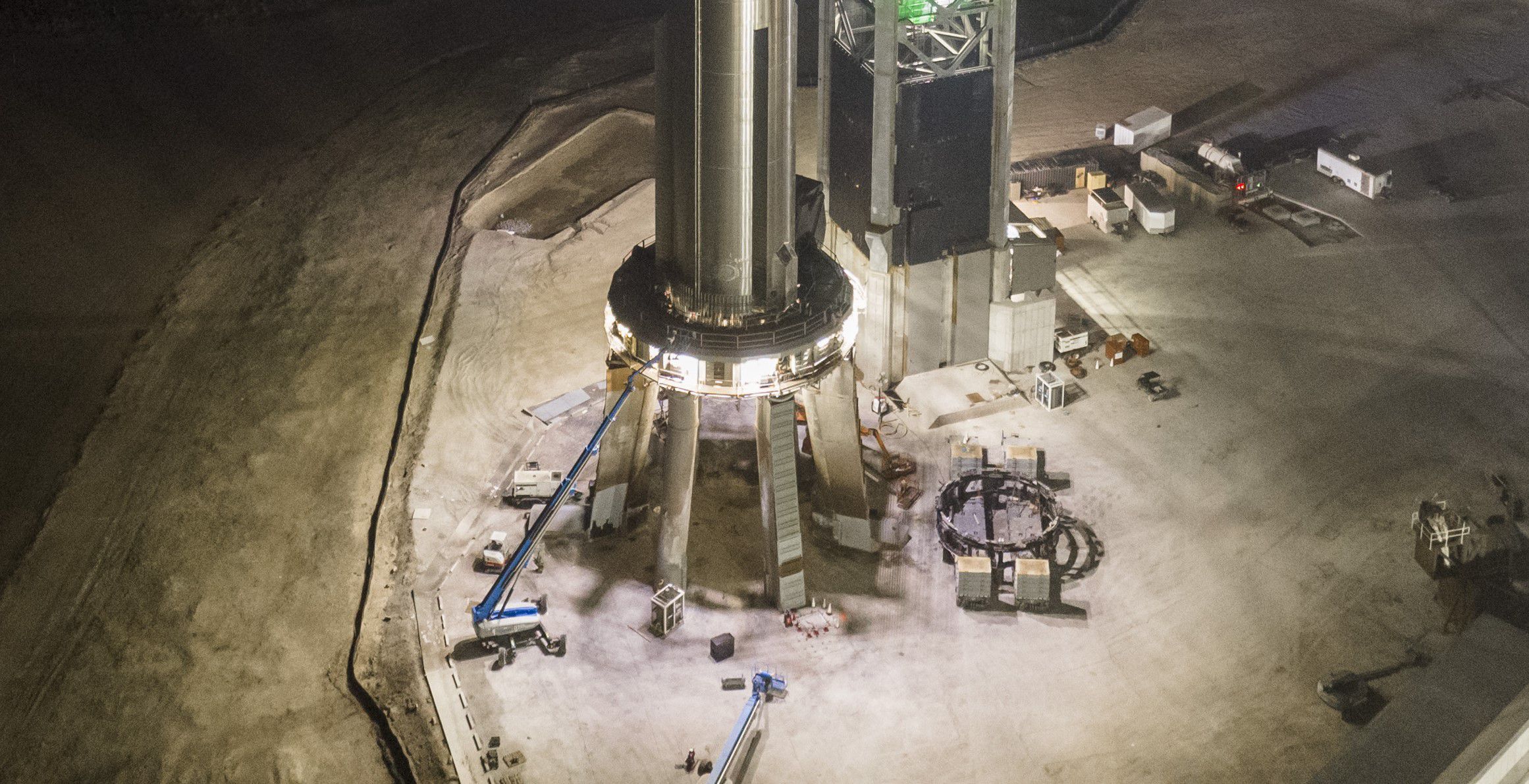

News
SpaceX to ship Starship ‘deluge’ hardware from Florida to Starbase
SpaceX appears to be preparing to ship a huge collection of hardware – including parts of a possible launch deluge system – from Florida to Texas.
Captured live by NASASpaceflight’s 24/7 Space Coast Live webcam, hardware began accumulating at NASA’s Kennedy Space Center (KSC) Turning Basin on January 12th. Within a few days, four midsize storage tanks, two or three large storage tanks, five high-pressure gas tanks, multiple sections of an apparent launch deluge system, and an unfinished Starship booster transport stand were all staged and ready for shipment. Save for implicit statements from reliable sources, there wasn’t an obvious guarantee that the hardware was all SpaceX’s or headed to the company’s Starbase, Texas factory and launch site.
But combined with the sheer volume of hardware and its privileged presence on NASA KSC property, the last part to arrive – the base of an unmistakable Starship (booster) transport stand – all but confirmed that the destination is Starbase. SpaceX has already shipped hardware from Florida to Starbase multiple times, including a trio of tanks sent in October 2022, which further increases the odds that everything visible is destined for Starbase.
The update that's rolling out to the fleet makes full use of the front and rear steering travel to minimize turning circle. In this case a reduction of 1.6 feet just over the air— Wes (@wmorrill3) April 16, 2024
It might also not be a coincidence that in its first attempt to build a Starship launch site at Kennedy Space Center, SpaceX installed four midsize tanks and plenty of high-pressure gas tanks at LC-39A. The resurgence of work on a totally different Starship pad design at 39A in late 2021 likely made that hardware redundant. It’s possible that the four smaller tanks set to be shipped to Starbase originated at 39A and are being moved in the hopes that they can be more useful elsewhere.
Additionally, satellite photos taken on January 3rd, 2023 and shared by Harry Stranger show a pair of larger tanks also sitting unused at Pad 39A. Ultimately, it’s almost certain that the delivery is SpaceX hardware bound for Starbase, Texas.
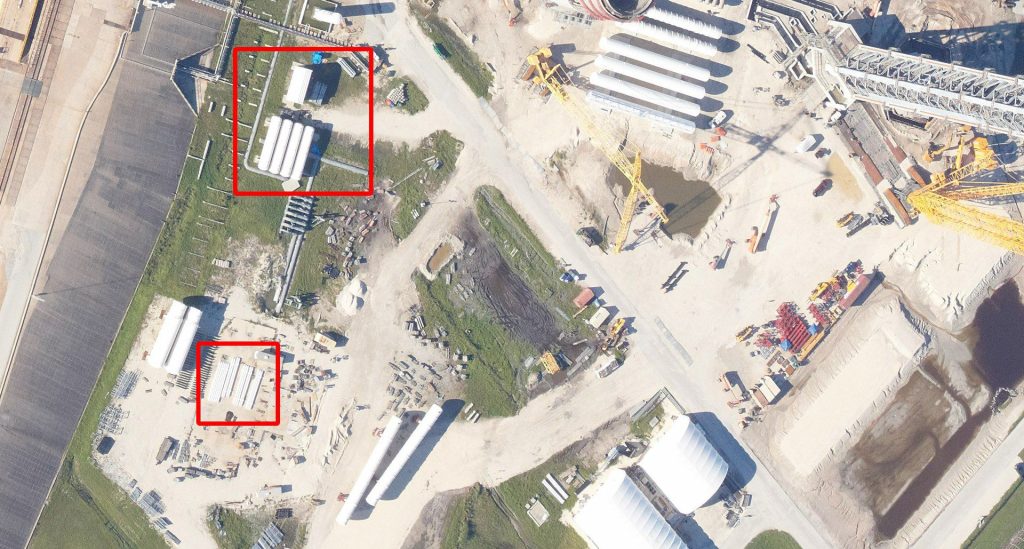
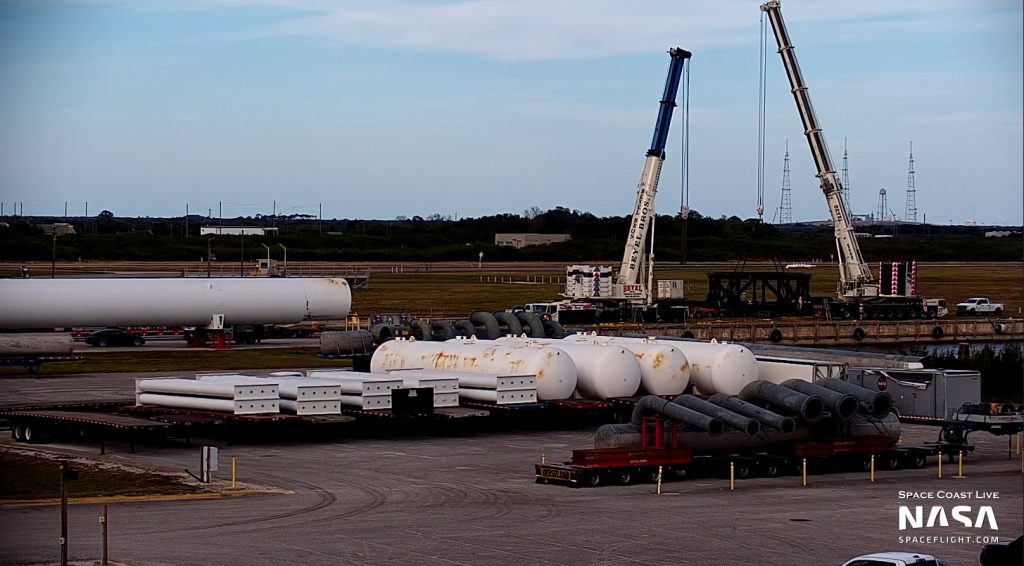
A deluge? Under my Starship?
The most interesting part of the shipment is arguably a group of giant metal tubes. Measuring several feet wide, dozens of feet long, and fitted with multiple outlets connected to the same giant pipe, the likeliest possible explanation is that the manifolds are part of a plan to upgrade SpaceX’s Texas Starship launch site with a deluge system.
Almost all rockets use some sort of deluge system to prevent their own exhaust from damaging or destroying themselves or their surroundings. A large volume of water sprayed into the space just below a rocket’s engines can prevent the immense acoustic energy (sound) they produce from wreaking havoc. A deluge also helps protect launch pad hardware by allowing some of the energy in the exhaust to boil and vaporize water instead of eating into concrete or steel. But CEO Elon Musk has infamously stated that SpaceX is intentionally attempting to build an orbital launch site that doesn’t need a flame diverter for Starship – the most powerful rocket in history.
That’s gone about as well as one might expect. Even Starship, which can produce about 18% as much thrust as Super Heavy, has repeatedly incinerated the concrete beneath its test stand, spreading molten debris for thousands of feet and starting major brush fires in a nature reserve. After every six-engine Starship static fire, SpaceX must painstakingly remove and replace all of the concrete beneath the test stand.
The problem is even more apparent at Starbase’s orbital launch mount, where SpaceX has begun to conduct Super Heavy booster static fire tests. Thus far, SpaceX has had to replace the concrete under the OLM after almost every Super Heavy static fire – a process that takes a week or two. The company recently replaced that concrete with a mix optimized to survive high temperatures, but it remains to be seen if that will survive a direct blow from the most powerful rocket in history.
For the time being, Starbase’s environmental permit only allows up to five orbital launches per year, making lengthy post-launch repairs mostly inconsequential. However, if SpaceX ever wants Starbase to rapidly launch multiple Starships back to back – essential for in-space refilling – or launch dozens of Starships per year, it’s become clear that a deluge system is likely essential.
Starship’s Florida deluge
Some part of SpaceX knows that. The design of Starship’s first Florida launch pad has already been upgraded to include a giant deluge ring embedded in the ground at the base of the mount. Unusual design aside, the structure is sized such that it’s almost certainly a high-flow deluge system capable of spraying thousands of gallons of water per second.
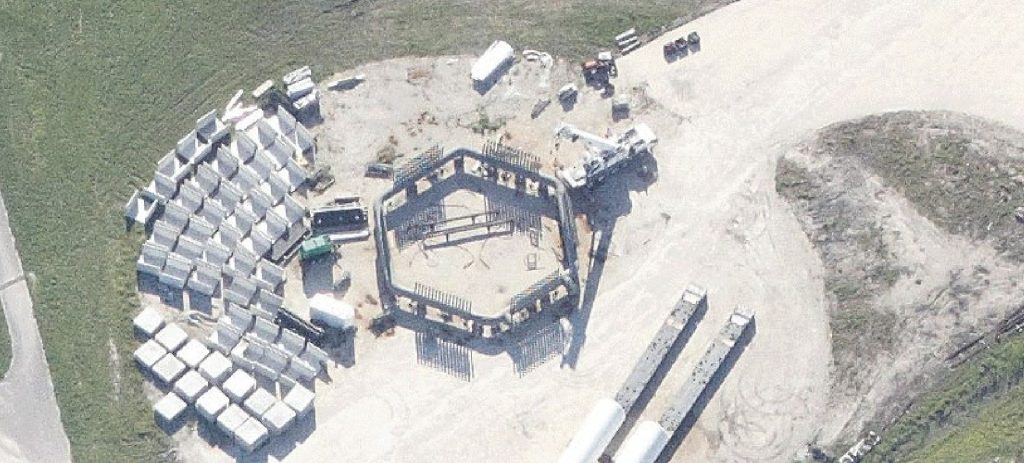
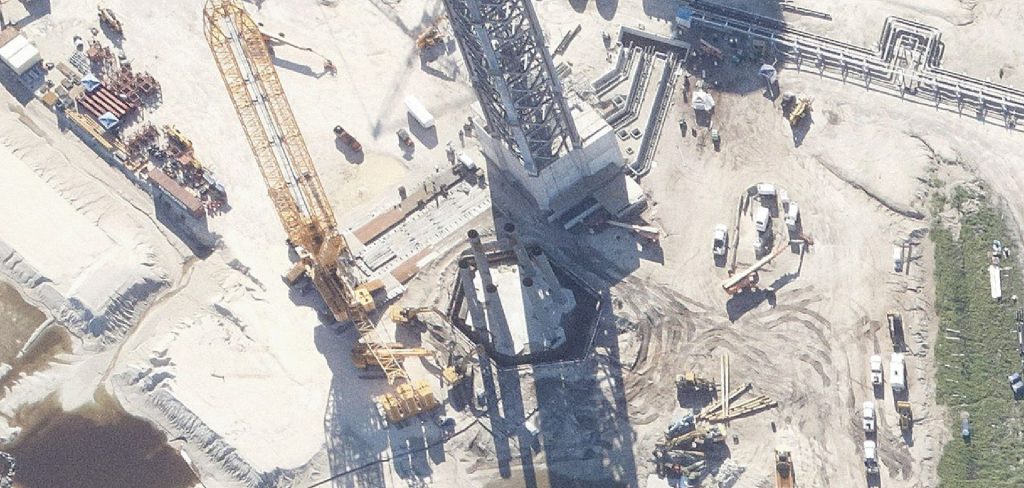
Three months later, SpaceX appears to be preparing to ship two giant deluge manifolds and some deluge plumbing from Florida to Starbase. If SpaceX intends to retrofit Starbase’s existing orbital launch site with a giant deluge system, the process would likely take months and render the pad more or less unusable from start to finish. Alternatively, Musk recently reported that SpaceX intends to build a “rocket test facility” at a separate property it purchased in South Texas. Located miles from the Starbase launch pad, the former gun range could potentially allow SpaceX to test Starships and Super Heavy boosters without disrupting orbital launch preparations and taking over Starbase’s only orbital launch mount.
Perhaps it’s not a coincidence that the same site – currently used for storage and limited Starship tank testing – already hosts some smaller parts of a potential Starbase deluge system. Regardless, it’s clear that significant changes are coming to Starbase and its associated facilities.
News
SpaceX’s Crew-11 mission targets July 31 launch amid tight ISS schedule
The flight will lift off from Launch Complex 39A at Kennedy Space Center in Florida.
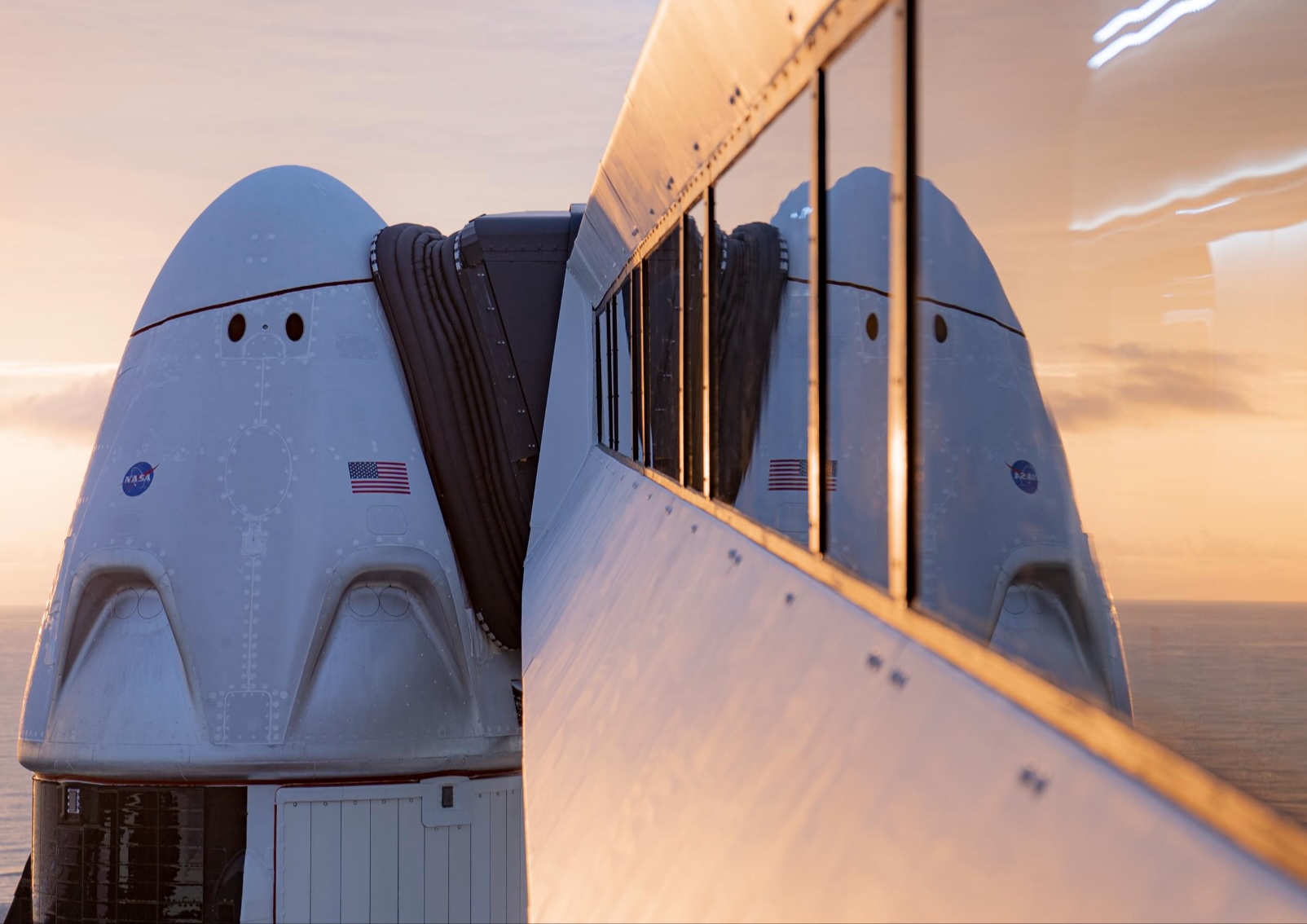
NASA and SpaceX are targeting July 31 for the launch of Crew-11, the next crewed mission to the International Space Station (ISS). The flight will lift off from Launch Complex 39A at Kennedy Space Center in Florida, using the Crew Dragon Endeavour and a Falcon 9 booster.
Crew Dragon Endeavour returns
Crew-11 will be the sixth flight for Endeavour, making it SpaceX’s most experienced crew vehicle to date. According to SpaceX’s director of Dragon mission management, Sarah Walker, Endeavour has already carried 18 astronauts representing eight countries since its first mission with NASA’s Bob Behnken and Doug Hurley in 2020, as noted in an MSN report.
“This Dragon spacecraft has successfully flown 18 crew members representing eight countries to space already, starting with (NASA astronauts) Bob (Behnken) and Doug (Hurley) in 2020, when it returned human spaceflight capabilities to the United States for the first time since the shuttle retired in July of 2011,” Walker said.
For this mission, Endeavour will debut SpaceX’s upgraded drogue 3.1 parachutes, designed to further enhance reentry safety. The parachutes are part of SpaceX’s ongoing improvements to its human-rated spacecraft, and Crew-11 will serve as their first operational test.
The Falcon 9 booster supporting this launch is core B1094, which has launched in two previous Starlink missions, as well as the private Ax-4 mission on June 25, as noted in a Space.com report.
The four-members of Crew-11 are NASA astronauts Zena Cardman and Mike Fincke, as well as Japan’s Kimiya Yui and Russia’s Oleg Platonov.
Tight launch timing
Crew-11 is slated to arrive at the ISS just as NASA coordinates a sequence of missions, including the departure of Crew-10 and the arrival of SpaceX’s CRS-33 mission. NASA’s Bill Spetch emphasized the need for careful planning amid limited launch resources, noting the importance of maintaining station altitude and resupply cadence.
“Providing multiple methods for us to maintain the station altitude is critically important as we continue to operate and get the most use out of our limited launch resources that we do have. We’re really looking forward to demonstrating that capability with (CRS-33) showing up after we get through the Crew-11 and Crew-10 handover,” Spetch stated.
Lifestyle
EV fans urge Tesla to acquire Unplugged Performance for edge in fleet and security industry
Unplugged Performance has built a name for itself by producing performance upgrades for Tesla vehicles.
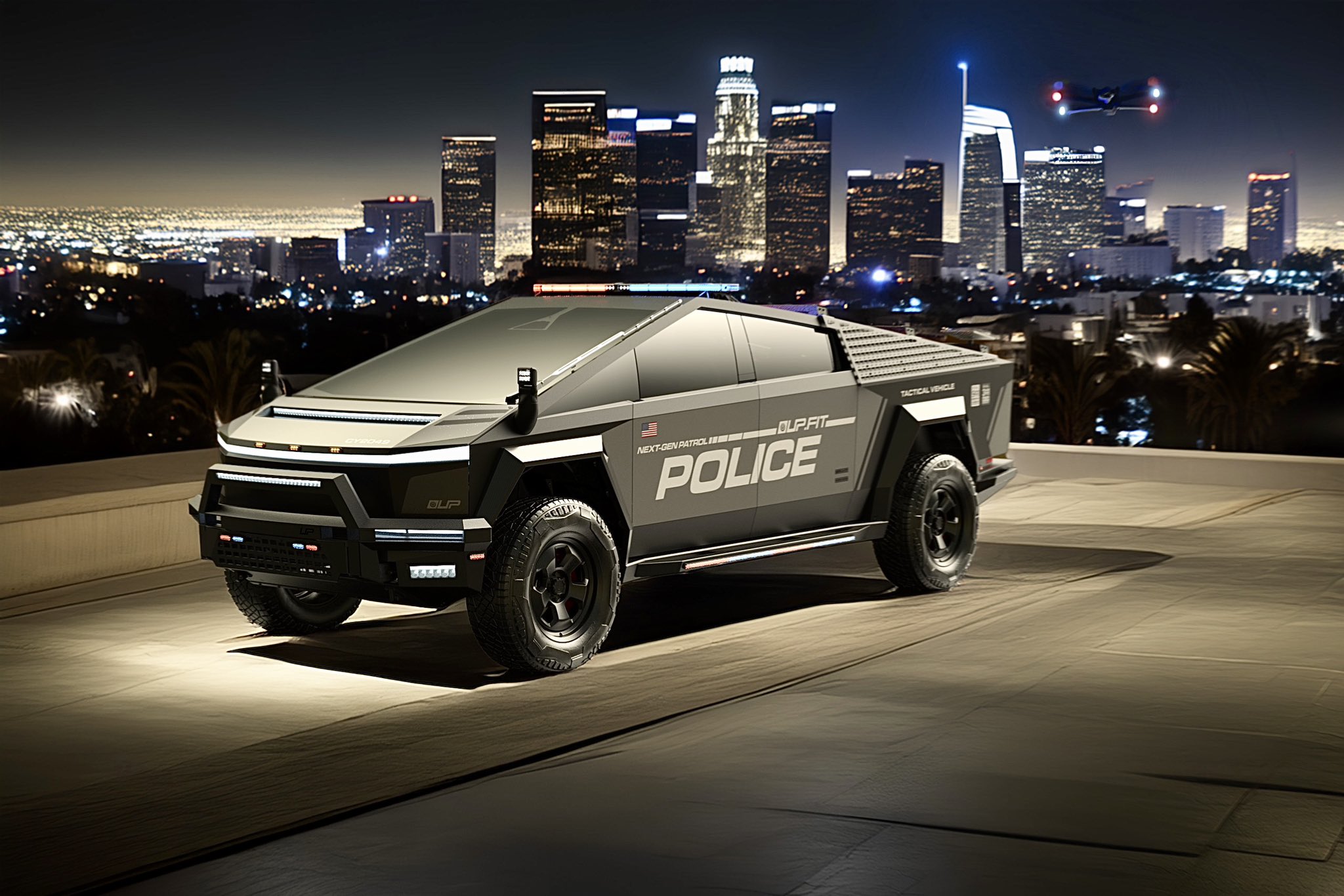
A growing number of Tesla enthusiasts and longtime community voices are calling on the electric vehicle maker to acquire Unplugged Performance, a California-based aftermarket company best known for tuning Tesla vehicles and developing specialized government fleet solutions under its UP.FIT division.
The idea was once considered a niche proposal among EV fans, but it is now gaining serious attention not just as a performance play but as a strategic move to deepen Tesla’s roots in the fleet and security industry.
A strategic fit
Unplugged Performance has built a name for itself by producing performance upgrades for Tesla vehicles, from track-optimized components to visual and aerodynamic upgrades. But in recent years, its UP.FIT division has pivoted toward a more functional future by outfitting Tesla vehicles like Model Ys for police, military, and government use.
That work has sparked growing calls for closer collaboration with Tesla, especially as the EV maker increasingly leans into autonomy, AI, and fleet services as core components of its next chapter.
“I posted this four years ago, but I think it’s more true now than ever,” wrote Whole Mars Catalog, a well-known Tesla investor and FSD Beta tester, on X. “Tesla should buy Unplugged. But not just as a Performance division. What they are doing with UP.FIT unlocks large government and commercial fleet purchases that can improve utilization.”
Tesla fans such as shareholder Sawyer Merritt echoed the sentiment, calling Unplugged a “great fit within Tesla.” adding, “They are literally located directly next to Tesla’s design studio in Hawthorne.”
Enabling the next wave
Supporters of the idea noted that integrating Unplugged into Tesla’s corporate structure could help accelerate the adoption of autonomous technologies in government sectors. With UP.FIT patrol cars already in use across some U.S. police departments, Tesla fans envisioned a future where self-driving Teslas could potentially revolutionize law enforcement, search-and-rescue, and public service logistics.
“Just imagine how autonomous patrol cars could transform policing and bring us into a safer future,” the veteran FSD tester wrote.
The benefits could also extend to Tesla’s existing consumer base. “They also have some incredible products in the works that I think will appeal to many ordinary Tesla drivers — not just those looking for performance or mods. Stuff that’s so good it should have come straight from the design studio next door,” Whole Mars Catalog noted.
Unplugged Performance, founded in 2013, shares not just a product vision with Tesla, but also geography. Its Hawthorne headquarters sits directly adjacent to Tesla’s design studio, and the two companies have maintained a close working relationship over the years. The aftermarket firm has long positioned itself as a “mission-aligned” partner to Tesla.
In response to the recent calls for acquisition, Unplugged Performance acknowledged the support from the community. “Our very existence is to support the Tesla mission with @UpfitTesla and @UnpluggedTesla,” Unplugged CEO Ben Schaffer posted on X. “We love working with Tesla and are grateful for the community’s support since 2013!”
News
Tesla debuts hands-free Grok AI with update 2025.26: What you need to know
All new Tesla vehicles delivered on or after July 12, 2025, will include Grok AI out of the box

Tesla has begun rolling out Grok, an in-car conversational AI assistant developed by xAI, to eligible vehicles starting July 12. The feature marks the most direct integration yet between Elon Musk’s artificial intelligence startup and Tesla’s consumer product lineup, offering drivers hands-free access to a chat-style companion while on the road.
Grok comes pre-installed on new vehicles
According to Tesla’s FAQ page for the feature, all new vehicles delivered on or after July 12, 2025, will include Grok AI out of the box. Owners of older vehicles may gain access through an over-the-air update, provided their vehicle meets a few hardware and software requirements.
Specifically, Grok is currently only supported on Tesla models equipped with an AMD infotainment processor and running vehicle software version 2025.26 and higher. Compatible models include the Model S, Model 3, Model X, Model Y, and Cybertruck. A Premium Connectivity subscription or active Wi-Fi connection is also required.
Tesla notes that additional vehicle compatibility may arrive in future software updates.
Grok’s features and limitations for now
Drivers can engage with Grok using the App Launcher or by pressing and holding the voice command button on the steering wheel. Grok is designed to answer questions and hold conversations using natural language, offering responses tailored to its chosen personality—ranging from “Storyteller” to the more eccentric “Unhinged.”
For fun, Tesla posted a demonstration of Grok likely running on “Unhinged” talking about what it would do to Optimus when they are on a date, much to the shock of the humanoid robot’s official social media account.
It should be noted, however, that Grok cannot currently issue commands to the vehicle itself, at least for now. Traditional voice commands for tasks like climate control, navigation, or media remain separate from Grok as of writing.
The feature is being released in Beta and does not require a Grok account or xAI subscription to activate, although that policy may change over time.
Grok privacy and in-car experience
Tesla emphasizes that interactions with Grok are securely processed by xAI and not linked to a user’s Tesla account or vehicle. Conversations remain anonymous unless a user signs into Grok separately to sync their history across devices.
Tesla has also begun promoting Grok directly on its official vehicle webpages, showcasing the feature as part of its in-car experience, further highlighting the company’s increasing focus on AI and infotainment features on its all-electric vehicles.
-

 Elon Musk2 weeks ago
Elon Musk2 weeks agoTesla investors will be shocked by Jim Cramer’s latest assessment
-

 Elon Musk3 days ago
Elon Musk3 days agoxAI launches Grok 4 with new $300/month SuperGrok Heavy subscription
-

 Elon Musk5 days ago
Elon Musk5 days agoElon Musk confirms Grok 4 launch on July 9 with livestream event
-

 News1 week ago
News1 week agoTesla Model 3 ranks as the safest new car in Europe for 2025, per Euro NCAP tests
-

 Elon Musk1 week ago
Elon Musk1 week agoxAI’s Memphis data center receives air permit despite community criticism
-

 News2 weeks ago
News2 weeks agoXiaomi CEO congratulates Tesla on first FSD delivery: “We have to continue learning!”
-

 Elon Musk2 weeks ago
Elon Musk2 weeks agoTesla scrambles after Musk sidekick exit, CEO takes over sales
-

 News2 weeks ago
News2 weeks agoTesla sees explosive sales growth in UK, Spain, and Netherlands in June


















